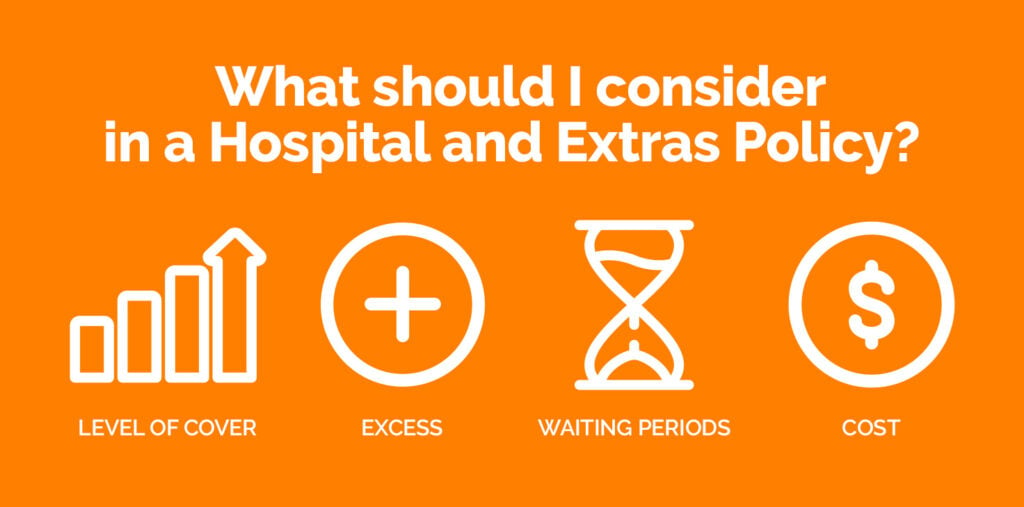Check out our range of private health funds
iSelect does not compare all providers or policies in the market and not all policies or special offers are available at all times, through all channels or in all areas. Not all policies available from our providers are compared by iSelect and due to commercial arrangements and customer circumstances, not all policies compared by iSelect are available to all customers. Learn more.
What’s the difference between Hospital Cover and Extras Cover?
Hospital Cover
Hospital Cover helps you out when you need to check into the hospital. You pay an excess – think of it as the price of admission – and then Medicare and your Hospital Cover both chip in to help you cover the total cost. It’s like splitting the bill, Health Insurance style.
Extras Cover
Extras Cover can handle things that Hospital Cover misses out on. It’s your go-to for treatments like dental, optometry, and other services that Medicare doesn’t cover.

How does a combined Hospital and Extras Policy work?
Imagine your Health Insurance is a combo meal – you order the burger (Hospital Cover) and the fries (Extras Cover). You don’t necessarily get a discount from ordering both together, but it definitely makes things a bit easier than going to two separate restaurants.
What should I consider in a Hospital and Extras Policy?
Level of cover
For Hospital Cover, consider which tier suits your needs – Basic, Bronze, Silver or Gold. For Extras, while there aren’t standard tiers, you can still choose different levels of coverage. You’ll be able to select a policy that suits your lifestyle and health needs, like picking a streaming service that fits your binge-watching habits.
Excess
Your excess is your entry fee to the hospital party – when you make a claim, it’s what you pay before your insurance kicks in. You’ll probably have a few excess amounts to choose from, and a higher excess often means lower premiums.
Waiting periods
When you sign up for a new policy or increase your level of cover, you’ll usually have to wait a little while before you can access your new coverage. While waiting periods are pretty standard across Hospital Policies, they can vary more for Extras Cover.
Cost
Your premium is your regular Health Insurance bill. As mentioned, a higher excess can mean lower premiums. You’ll also find a bit of variation in premiums between providers. It’s worth considering your premiums alongside your level of cover, to make sure you’re achieving a good balance between what you’re paying and what you’re getting for it.

Frequently Asked Questions
What are the pros of a combined policy?
Having a combined policy is like having a one-stop shop for your Health Insurance needs. No more juggling calls between two insurers – it’s all under the same roof (and the same membership card or app!). Hospital Cover takes care of the serious stuff and Extras swoop in for the everyday heroics. Instead of paying separate premiums for Hospital and Extras, you get one bill and less hassle.
What are the cons of a combined policy?
A combined policy isn’t always the right choice. Sure, it makes things a bit easier, but it’s important to make sure you actually want the coverage you’re paying for. And with a combined policy, you’re sticking to a single insurer’s menu – less choice means you could miss out on a better deal.
Do I have to have my Hospital and Extras Policies with the same Health Fund?
Nope! You’re the boss of your Health Insurance game. Having your Hospital and Extras Policies under the same Health Fund is like wearing matching socks – nice, but not mandatory. Getting them separate is like building your own playlist – more tailored to you, but you have to do the tailoring yourself. It’s your health, your call.
Do waiting periods apply before I can claim against my Hospital or Extras Coverage?
They do. For Hospital Cover, the government has set the following maximum waiting periods:
- 12 months for pre-existing conditions, pregnancy and birth
- Two months for psychiatric care, rehab or palliative care, including for pre-existing conditions
- Two months for everything else.
The exception to this is if you’re switching from a policy with the same or a higher level of coverage. If you’ve already served waiting periods on your previous policy, you don’t have to serve them again.
For Extras Cover, there are no government-mandated waiting periods, so you might find that they vary a bit more. However, sometimes health funds do offer waivers on some Extras waiting periods.
Do I have to have Hospital and Extras Cover to avoid Lifetime Healthcare Loading or the Medicare Levy Surcharge?
If you skip getting Hospital Cover by 1 July after hitting the big 3-1, once you do get it, there’ll be a 2% extra charge on your premium for every year you went without coverage (maxing out at 70%). This little extra is called Lifetime Healthcare (LHC) Loading.
And that’s not the only additional charge you could be in for. The Medicare Levy Surcharge (MLS) is an extra tax you might need to pay if your income is more than $93,000 for singles or $186,000 for families and couples and you don’t have Hospital Cover.
To dodge LHC Loading, you’ve got to have your basics covered with Hospital Cover. Extras Cover is like an optional side dish – nice to have, but it won’t help you avoid either LHC loading or the MLS. So, remember, if it’s just Extras in your Health Insurance basket, you might end up footing that LHC bill or paying extra tax thanks to the MLS.
Where can I find and compare Hospital and Extras Policies?
Consider us your Health Insurance matchmaker. You can dive into the world of Hospital and Extras Policies, sizing up benefits and prices right next to each other. Whether you’re into the full package deal or prefer a mix-and-match strategy with different providers, we’re here to help.
You can do this comparison online. Or, if you want to chat it out, hit up our comparison experts at 1800 784 772. They’ll guide you through the Health Insurance maze like the pros they are.

.svg)













